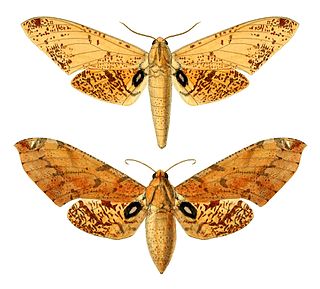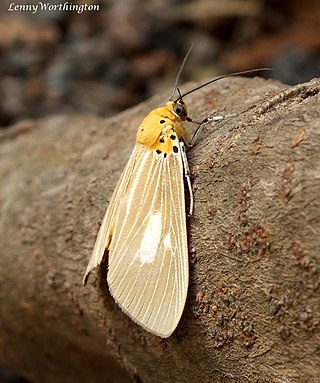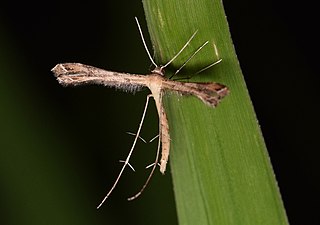Dalaca is a genus of moths of the family Hepialidae. There are 23 described species found throughout South America as far north as Panama. The larvae feed on grasses.

The red-legged pademelon is a species of small macropod found on the northeastern coast of Australia and in New Guinea. In Australia it has a scattered distribution from the tip of Cape York Peninsula in Queensland to around Tamworth in New South Wales. In New Guinea it is found in south central lowlands.
Balacra is a genus of moths in the family Erebidae.

Ricaniidae is a family of planthopper insects, containing over 400 species worldwide. The highest diversity is in tropical Africa and Asia and in Australia, with a few species occurring in the Palearctic and Neotropical realms. It is one of the smaller families in the planthopper superfamily Fulgoroidea.
Pachymetoides is a monotypic moth genus in the family Lasiocampidae described by Strand in 1912. Its single species, Pachymetoides stigmatica, described by the same author in the same year, is found in Gabon and Nigeria.

Platysphinx is a genus of moths in the family Sphingidae first described by Walter Rothschild and Karl Jordan in 1903.
Hypocoena stigmatica is a species of moth of the family Noctuidae. It is found on the Faroe Islands and Iceland, as well as parts of Russia and Alaska.

Xestia stigmatica, the square-spotted clay, is a moth of the family Noctuidae. It is found in most of Europe, Transcaucasia, Caucasus, Kazakhstan, northern Turkey and northern Iran.

Asota plaginota is a moth of the family Erebidae first described by Arthur Gardiner Butler in 1875. It is found in China, India, Indonesia, Myanmar, Malaysia, Nepal, Papua New Guinea, the Philippines, Sikkim, Singapore, Sri Lanka, Thailand and Vietnam. In Northeast India, it is recorded as a millet pest.
Stenoptilodes stigmatica is a moth of the family Pterophoridae that is known from Colombia, Ecuador and Venezuela.

Stenoptilodes is a genus of moths in the family Pterophoridae.

Platysphinx stigmatica is a moth of the family Sphingidae. It is known from forests from Nigeria to the Congo, Angola and western Uganda.
Lepturgotrichona is a genus of beetles in the family Cerambycidae, containing the following species:
Eugnosta stigmatica is a species of moth of the family Tortricidae. It is found in South Africa.
Roerichiora stigmatica is a moth in the family Cossidae. It is found in India, Bhutan, Vietnam and Thailand.

Sybra stigmatica is a species of beetle in the family Cerambycidae. It was described by Pascoe in 1859. It is known from Indonesia.

Ricanula is a genus of planthopper belonging to family Ricaniidae.
Alienopterus brachyelytrus is an extinct insect described from a 99 million year old fossil found in Burmese amber from the Hukawng Valley of Myanmar. It was the first known member of the order Alienoptera until 2018, when the second and third members of the order, Caputoraptor elegans, and Alienopterella stigmatica were described. A. brachyelytrus has characters that are shared with cockroaches and mantids and is thought to represent either the sister taxon, or an ancestor to mantids.
Corrhenes stigmatica is a species of beetle in the family Cerambycidae. It was described by Francis Polkinghorne Pascoe in 1863. It is known from Australia.
Micropeza stigmatica is a species of stilt-legged flies in the family Micropezidae.








